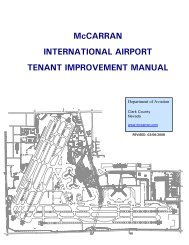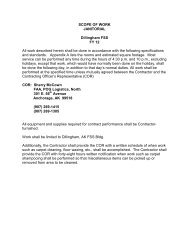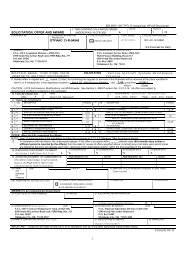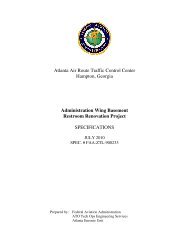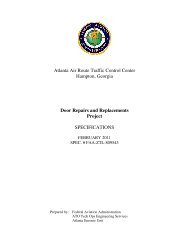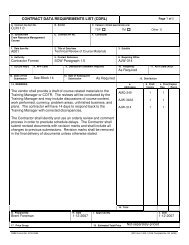scope of work - FAACO - Federal Aviation Administration Contract ...
scope of work - FAACO - Federal Aviation Administration Contract ...
scope of work - FAACO - Federal Aviation Administration Contract ...
You also want an ePaper? Increase the reach of your titles
YUMPU automatically turns print PDFs into web optimized ePapers that Google loves.
A/E Scope <strong>of</strong> Work<br />
Las Vegas ATCT/TRACON<br />
F. Electrical Design<br />
tamper monitoring, fire fighters telephone, elevator interfaces, HVAC<br />
interfaces and appropriate audible and visual signaling. The fire<br />
alarm system shall be capable <strong>of</strong> fire pump monitoring, stair<br />
pressurization monitoring and manual/automatic control from fire<br />
alarm system. Provide for elevator primary and secondary recall<br />
functions. Provide Digital Alarm Communicator/Transmitter (DACT)<br />
to communicate with a fire alarm monitoring service. Coordinate the<br />
system requirements to be compatible with the airport system or local<br />
monitoring agency. The contract shall have requirements for two<br />
years <strong>of</strong> maintenance and monitoring.<br />
iv. Building construction based on occupancy types, with fire resistive wall and<br />
floor requirements, interior finishes, fire/smoke dampers, fire rated<br />
penetrations, door ratings, building height, story and area limitations and<br />
presence <strong>of</strong> combustible materials.<br />
1. The A/E will be responsible for incorporating a Critical Power Distribution System<br />
Type 2A (CPDS-2A) into the Las Vegas ATCT/TRACON design. The CPDS-2A is a<br />
government-furnished, contractor-installed system. The individual components for<br />
the CPDS-2A will be government-furnished down to the panelboard level. The A/E<br />
Design Engineer shall use the attached Design Guidelines for a Type 2A CPDS.<br />
2. As part <strong>of</strong> the CPDS-2A design, the A/E shall develop an itemized list <strong>of</strong> all<br />
government-furnished equipment (GFE), which will consist <strong>of</strong>, but not limited to, an<br />
engine generators package, static transfer switches, uninterruptible power supplies,<br />
transient voltage surge suppressors, and electrical distribution gear. See the Design<br />
Guidelines for the Type 2A CPDS.<br />
3. The building electrical system shall be provided with electronic metering/monitoring<br />
capable <strong>of</strong> monitoring voltage, amperage, power factor, kva, kvar, watts, watt-hours,<br />
waveforms, harmonics, etc. The system shall be provided with a remote PC<br />
complete with s<strong>of</strong>tware for analysis that is capable <strong>of</strong> remote access via the Internet.<br />
The extent <strong>of</strong> the monitoring system shall be as depicted in the Design Guidelines<br />
for the Type 2A CPDS. The designer shall provide contractor installation drawings<br />
for the power monitoring system.<br />
4. The electrical capacity <strong>of</strong> the facility shall be designed for actual facility<br />
requirements. The A/E shall obtain fault current data from the electrical service<br />
company, and perform short circuit analysis and protective device coordination<br />
calculations (using EDSA Micro Corporation s<strong>of</strong>tware) for the electrical distribution<br />
system in accordance with appropriate FAA orders, standards, and other applicable<br />
codes. The engineer responsible for these studies shall be a Registered<br />
Pr<strong>of</strong>essional Electrical Engineer with at least ten (10) years <strong>of</strong> experience, who<br />
specializes in performing power system studies. The study shall be in accordance<br />
with the specific procedures outlined in IEEE 141 (Red Book) and ANSI/IEEE 242<br />
25




